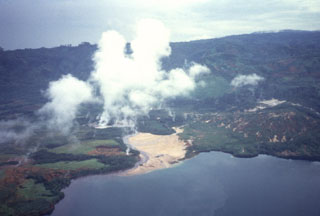Report on Suoh (Indonesia) — February 1994
Bulletin of the Global Volcanism Network, vol. 19, no. 2 (February 1994)
Managing Editor: Richard Wunderman.
Suoh (Indonesia) A major earthquake apparently triggers a phreatic eruption 2 weeks later
Please cite this report as:
Global Volcanism Program, 1994. Report on Suoh (Indonesia) (Wunderman, R., ed.). Bulletin of the Global Volcanism Network, 19:2. Smithsonian Institution. https://doi.org/10.5479/si.GVP.BGVN199402-261270
Suoh
Indonesia
5.25°S, 104.27°E; summit elev. 1000 m
All times are local (unless otherwise noted)
. . . an eruption occurred in the Suoh hot-spring field two weeks after a major earthquake in the region [but see 19:4]. If confirmed, it will be the second time in this century that Suoh erupted two weeks after a large earthquake. As of late February, Indonesian scientists had found two new 5-m-diameter craters that were erupting hot gas-charged mud to 10 m height. The public was not allowed within 100 m of the craters.
The earthquake took place on 15 February, a few tens of kilometers SE of Suoh (5.4°S, 104.8°E) and had a shallow focal depth. The earthquake's magnitude was reported as 7.2 by the NEIC, but press reports stated that officials in Jakarta determined it to be M 6.5. The earthquake apparently caused extensive damage and at least 215 deaths . . . .
This latest seismically triggered outburst was less vigorous than the one in 1933 . . . .
Geological Summary. The 8 x 16 km Suoh (or Suwoh) depression appears to have a dominantly tectonic origin, but contains a smaller complex of overlapping calderas oriented NNE-SSW. Historically active maars and silicic domes lie along the margins of the depression, which falls along the Great Sumatran Fault that extends the length of the island. Numerous hot springs occur along faults within the depression, which contains the Pematang Bata fumarole field. Large phreatic explosions (0.2 km2 tephra) occurred at the time of a major tectonic earthquake in 1933. Very minor hydrothermal explosions produced two 5-m-wide craters at the time of a February 1994 earthquake.
Information Contacts: G. Melosh, Unocal Geothermal Division; NEIC; AP.

